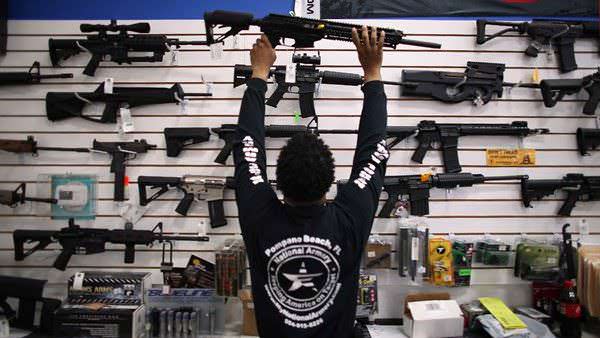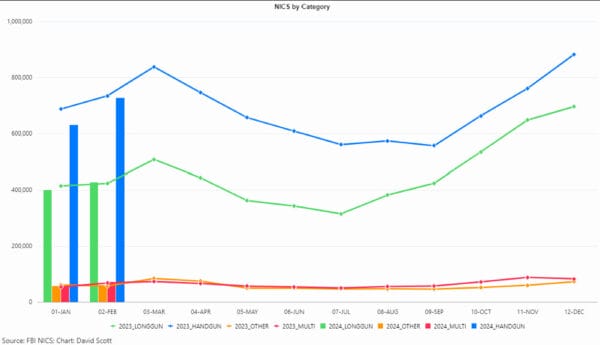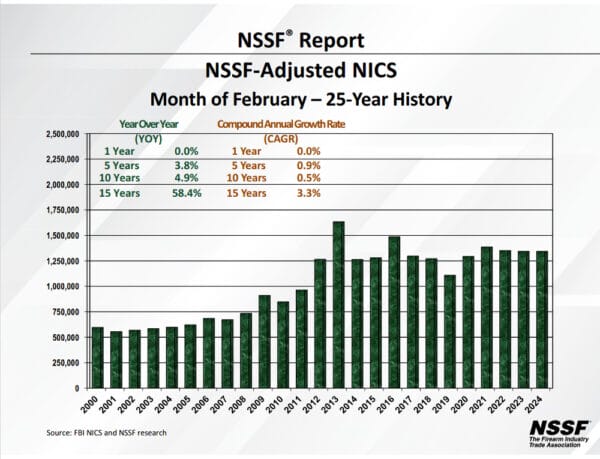
The number of National Instant Background Check System (NICS) checks and estimated gun sales show little change from 2023. In February 2024, the number of gun sales was 99.7% of what they were in February of 2023. Total estimated gun sales in February of 2024 are 1.29 million. In February 2023, they were 1.29 million.
There was a sales difference of about 4,000 between the two months. This makes February 2024 the fifth-highest February for gun sales recorded in the NICS system and the sixth-highest February for total background checks done. The numbers for the various types of gun sales recorded were close to those in February of 2023. Handgun sales were slightly lower and long gun sales were slightly higher.
The National Shooting Sports Foundation has adjusted NICS numbers for February over the 25 years of history available. Sales were fairly flat from 2000 to 2007, then trended up during the Barak Obama Presidency, with a relatively new normal starting in 2012.


There are about 505 million privately owned firearms in the United States today.
To estimate the number of civilian-owned guns in the United States, this correspondent uses the method pioneered by Newton and Zimring in 1972. The method was extended by Professor Gary Kleck through 1987 in his highly acclaimed book “Point Blank: Guns and Violence in America” p. 49-50. Numbers from the Alcohol, Tobacco and Firearms (ATF) are used to update the estimates through 2022. Estimates derived from corrected FBI figures in NICS are used for 2023 to the current time.
Using the Newton-Zimring-Kleck method, there are about 505 million privately owned firearms in the United States of America to date. This is essentially the same method used by the Small Arms Survey based in Switzerland. According to the Small Arms Survey, the private stock in the USA was about 393 million at the end of 2017. About 95 million firearms have been added to the private stock since the end of 2017. An updated Small Arms Survey figure would be about 490 million firearms in the USA private stock. Given the uncertainties of the data, the two numbers are reasonably close.
Why does the United States of America dwarf the rest of the world in the number of firearms owned per capita? Here are two obvious reasons.
The foremost reason is that the government of the USA has not imposed strong restrictions on the ownership of common arms (although some state governments have), in large part because of the Second Amendment of the Bill of Rights in the United States Constitution. Firearms are desirable possessions for large numbers of people. For a great many people, they are seen as necessities rather than luxuries. When government-imposed restrictions on the ownership of firearms are removed, the number of firearms owned by the population increases dramatically.
A second reason is the relative prosperity of the population. Unskilled labor in the USA today can earn about $100 a day. In much of the world, unskilled labor has difficulty earning $2 a day. Two hundred and fifty years ago, a rifle cost the equivalent of $22,000 today. A musket would cost about one-third of that amount. A far more capable modern single-shot shotgun today can be purchased new for $120. Reasonably quality firearms are much more affordable today than they used to be.
People in the USA have much more disposable income than people in most of the world. For the cost of a bit over a day’s labor, an ordinary person can purchase an inexpensive shotgun or rifle. For two days of labor, a perfectly usable revolver or semi-automatic handgun is available. For a week’s labor, a decent quality AR15, suitable for militia service and defense of self, home, and community, is available from multiple sources.
Residents of many countries envy the United States for its freedom, security, and Second Amendment.
About Dean Weingarten:
Dean Weingarten has been a peace officer, a military officer, was on the University of Wisconsin Pistol Team for four years, and was first certified to teach firearms safety in 1973. He taught the Arizona concealed carry course for fifteen years until the goal of Constitutional Carry was attained. He has degrees in meteorology and mining engineering, and retired from the Department of Defense after a 30 year career in Army Research, Development, Testing, and Evaluation.

from https://ift.tt/rkhEYiZ
via IFTTT

No comments:
Post a Comment